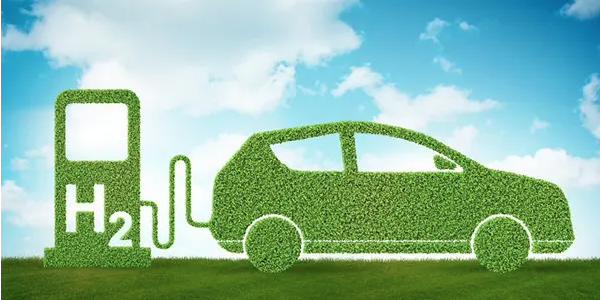Hydrogen-fueled vehicles could be an important step toward a cleaner planet. Hydrogen emits no chemicals other than water vapor, helping to reduce harmful carbon dioxide and air pollution levels. Although hydrogen is one of the most abundant elements on Earth, it is currently expensive to extract from non-fossil resources.
Hydrogen is typically extracted through a process known as natural gas methane steam shifting, but separating the water electrochemically is cleaner and more sustainable. The process uses catalysts that speed up chemical reactions without any permanent chemical changes themselves. However, green technology costs have been a hurdle in the market.

The research team detected and confirmed their new findings through resources from the Advanced Photon Source (APS) and the U.S. Department of Energy's (DOE) Argonne National Laboratory's Division of Science.
According to research by OSU chemical engineering professor Zhenzing Feng, catalysts often undergo structural changes during the promotion reaction. Sometimes changes are reversible, sometimes irreversible, and irreversible structural rearrangements are thought to reduce the ability of catalysts to affect chemical reactions.
Prof. Zhenzing Feng, OSU PhD student Maoyu Wang, and collaborators studied the structure of the catalyst in the reaction, and then manipulated its surface structure and composition at the atomic scale for efficient hydrogen production catalysis. The new catalyst is based on irregular iridium hydroxide, which is 150 times more efficient than the original structure employed and nearly three orders of magnitude (equivalent to 1,000 times) better than the common commercial catalyst, iridium oxide.
"We found at least two groups of materials to undergo irreversible changes, which turned out to be better catalysts for hydrogen production," Feng said. "This could help us produce hydrogen at a price of $2 per kilogram, ultimately down to $1 per kilo."
The U.S. Department of Energy (DOE) launched the “Energy Earthshots” initiative to accelerate breakthroughs in more abundant, affordable and reliable clean energy solutions, setting a target to reduce the cost of clean hydrogen by 80% within a decade, at a price At the target of $1 per kilogram ("111"). The Infrastructure Act, signed into law in November 2021, authorizes an $8 billion program to support the development of clean hydrogen hubs in at least four regions, creating a network of hydrogen producers, storers, transporters, and transportation infrastructure.
Feng and his research team used several X-ray techniques through an advanced photon source to validate their findings. The work was done on beamlines 9-BM and 4-ID-C, and the research team was able to observe the electrochemical process taking place, thereby gaining information on catalyst changes in real time.
"Materials that are good catalysts are often unstable," explains John Freeland, an Argonne physicist and co-author of the Science Advances paper. "When a material is activated, it can be difficult to tell whether the material will be a good catalyst, and whether it will get The expected result, or whether it is consumed in the process of releasing the hydrogen. If it is consumed, there is no catalyst left."
That's what Advanced Photon Sources do. Using ultra-bright X-rays, scientists can obtain chemical and structural information on an extremely small scale, not only to see what's going on inside a material as it reacts, but also to see what's going on on the surface of the material to see if it's eroded or transformed.
George Sterbinsky, an Argonne physicist and co-author of the Science Advances paper, said: "X-ray absorption spectroscopy allows us to look at atomic structure and see how it has changed. X-ray absorption spectroscopy gives us both chemistry and structure. information so that we can understand the catalytic process."
A comprehensive understanding is important because the materials commonly used in catalysts (eg, iridium) are often very expensive. Advanced photon sources, which have been used in catalysts for years, can provide the research team with experience to ensure their experiments are successful, Freeland said.
"It's not an easy thing to do well," he said. "It could be wrong in many ways, and we can help researchers get the data they want."
The Advanced Photon Source is undergoing a massive upgrade to boost the brightness of X-rays by a factor of 500, and Freeland points out that catalyst research will get even better once the upgraded facility comes online. Brighter X-rays will allow researchers to scale up these experiments to a smaller scale, using microscopic samples of catalysts and gain better structural and chemical information from them.
Feng's research team focuses on water electrolysis technology for clean hydrogen production, which uses electricity from renewable energy sources to separate water to produce clean hydrogen. However, Feng said, the efficiency of water splitting is low, mainly due to the high overpotential for a critical part of the process, the difference between the actual and theoretical potential of the electrochemical reaction.
Feng said: "Catalysts are crucial for promoting the water splitting reaction by reducing the overpotential, thus reducing the cost of hydrogen production. Our first published research paper in JACS Au lays the foundation for us, as we did in " As demonstrated in the Science Advances article, we can now better manipulate the atoms on the surface to design catalysts with the desired structure and composition."
Co-authors of these research papers include University of Texas, Peking University, Pacific Northwest National Laboratory, Northwestern University, and South China University of Technology. University of Technology, the University of Cambridge, the University of California, Berkeley and Singapore's Nanyang Technological University.

